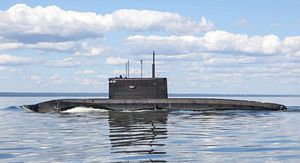The Russian Ministry of Defense has confirmed the expected delivery date of two new Project 636.3 Kilo-class (aka Vashavyanka-class) diesel-electric attack submarines in a August 14 statement. “Two Project 636.6 Varshavyanka-class diesel-electric submarines named Petropavlovsk-Kanchatsky and Volkhov will be added to the Russian navy by the end of 2020, provided that their in-plant and state tests go well,” the statement reads.
As I reported earlier this month, the two new submarines are destined for Russia’s Pacific Fleet. The two boats were laid down at the Admiralty shipyards in Saint Petersburg on July 28 in the presence of Russian Deputy Defense Minister Yuri Borisov. The first submarine will likely be delivered to the Pacific Fleet in 2019 with the second boat expected to arrive in the Russian Far East the following year.
“The decision to accelerate the construction of Kilo-class subs was partially made due to delays in the Project 677 Lada-class diesel-electric attack submarine program,” I reported earlier this month. “Although, the Russian Navy expected to operate three Lada-class subs by the end of 2018, so far only the lead boat of the class has entered service and is currently undergoing operational testing.”
The Project 636.3 Kilo-class is an improved variant of the original Project 877 Kilo-class design (nicknamed “Black Holes” by the U.S. Navy). The updated version is slightly longer in length, and features improved engines and noise reduction technology. Project 636.6 boats are also extremely quiet. Among other things, the sub features a special anechoic coating applied on the outer hull surface to reduce noise emanating from the boat’s interior. Furthermore, the sub’s main propulsion plant is isolated on a rubber base preventing vibrations that can be picked up by enemy submarines.
The submarine’s range is over 7,500 nautical miles and it can stay submerged for almost two weeks. It can operate for up to 45 days before needing to be resupplied. However, the sub still lacks an air-independent propulsion (AIP) system. Russia has so far not successfully tested an AIP system aboard a submarine. According to experts, the first AIP system for Russian subs will not be available for testing until 2021-2022.
The improved Kilo-class can fire both torpedoes and cruise missiles, launched from one of six 533 millimeter torpedo tubes. Project 636.3 Kilo-class subs have been primarily designed for anti-submarine and anti-surface ship warfare. However, over the past two years, Project 636.3 subs have repeatedly attacked land targets with M-54 Kalibr (NATO designation: SS-N-27A “Sizzler”) cruise missiles in Syria.































